14 reasons why Lazio should be your next Italian holiday destination

Often bypassed in favour of its northern neighbours Tuscany and Umbria, Lazio is brimming with treasures of its own.
This large region contains too many places of interest to fit into one article, so we’ve restricted this piece to the provinces of Viterbo and Rome in northern and western Lazio.
Here’s why they should be your next holiday destination.
1. The lakes
The first reason to visit north and west Lazio is really four: the two large lakes of Bracciano and Bolsena, and the two smaller lakes of Martignano and Vico.
Lago di Bracciano is surrounded by the towns of Bracciano, Anguillara Sabazia, and Trevignano Romano, the first two of which can be reached from Rome by train for the price of a couple of cappuccinos. Pay a visit to Odescalchi Castle in Bracciano, walk among the picturesque streets of Anguillara which spill down into the lake, and eat fresh lake fish at one of the many restaurants along the tree-lined waterfront in Trevignano.
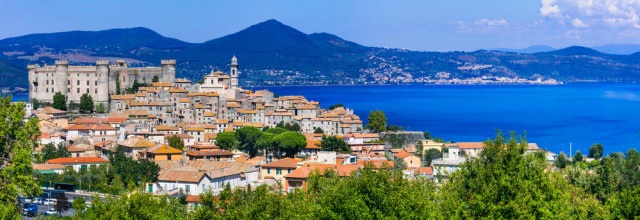
Bracciano castle and lake. Photo: Maugli/Depositphotos
If you want to feel truly immersed in nature, make a short trip to the neighbouring Lago di Martignano. You’ll need to drive for several minutes along a bumpy dirt road and park your car a walk away from the lake itself, but you’ll be rewarded with a truly peaceful setting, far from the traffic, amid idyllic grassy banks.
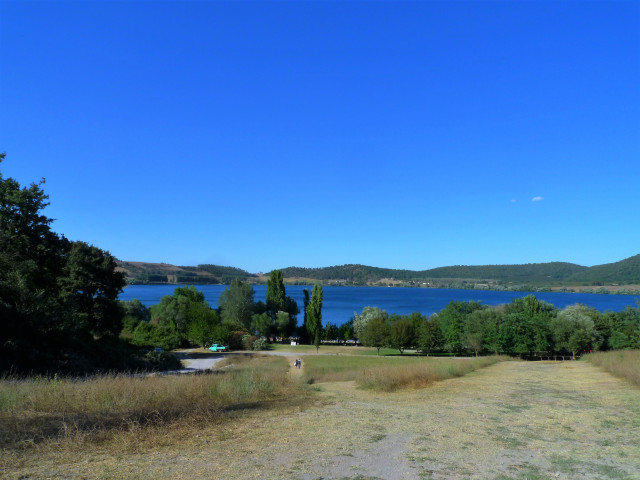
Lago di Martignano. Photo: Elaine Allaby
The more northerly Lago di Bolsena is home to the towns of Bolsena, Marta, and Capodimonte. Relax by the lake in historic Marta and Capodimonte, admire the medieval beauty of the more lively Bolsena, and stop by the town of Montefiascone which offers stunning views over the lake. If you have time, rent a boat or take your own kayak around the islands of Bisentina and Martana. Both islands are privately owned but Bisentina, which houses a Franciscan convent with seven crumbling oratories, recently came into new hands and its current owners are looking at opening it up to tourists.
Roughly midway between Bolsena and Bracciano is the smaller Lago di Vico, which is situated in a nature reserve and is arguably the wildest of the four lakes. Comfort-seekers can rent a sun lounger and dine at one of the bars and restaurants on the south side of the lake, but more adventurous visitors can also explore the unspoilt wildlife around the rest of its perimeter, where hazelnut groves abound and farmers bring herds of pigs and cattle down to the water to drink.
All the lakes are clean enough to swim in and (unlike many of Italy’s beaches) have plenty of undeveloped public shores where you can put down a towel and stay for free.
2. The beaches of Santa Severa and Santa Marinella
If you prefer saltwater to freshwater, head west to the twin beaches of Santa Marinella and Santa Severa, both a short distance from Rome and easily accessible by train. They make up two of the limited number of Italian beaches with free public access, and form part of a golden coastline by the pristine waters of the Tyrrhenian Sea. Santa Severa has a castle on the beach itself which is open to visitors for a small entry fee and is well worth a visit.
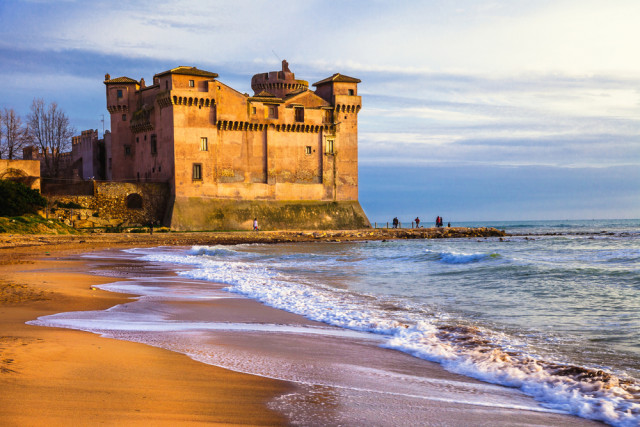
Santa Severa's beach and castle. Photo: Maugli/Depositphotos
READ ALSO: 13 places in Italy that look like they belong in a fairy tale
3. The opulent house and gardens of Villa Farnese
Not to be confused with Palazzo Farnese in central Rome where France's embassy to Italy is currently housed, Villa Farnese (confusingly sometimes also called Palazzo Farnese) in Caprarola is a magnificent 16th-century villa with a unique pentagonal shape. Admire the villa’s distinctive spiral staircase, take a walk in its sumptuous rooms decorated in the Mannerist style, which include 500-year-old world atlas frescoes, and stroll among its vast decorative gardens which extend for several acres behind the villa itself.
READ ALSO: Italy's best-kept secrets: Ten must-see places
4. Viterbo, the “City of the Popes”
Being a pope in middle ages, a time when the Catholic Church was beset with conspiracies and intrigue, was a dangerous business. Enter Viterbo, Lazio’s second city after Rome and the refuge of numerous medieval pontiffs. The city traces its origins back to the pre-Roman Etruscan civilisation, but the buildings and streets in its historic centre date back to the 12th and 13th centuries when it rose to prominence as the “City of the Popes” and briefly became the seat of the papacy in 1257. Walk the scenic streets around the papal palace and take a guided underground tour of the Etruscan tunnels which were enlarged and repurposed as secret passageways in medieval times, and later used as air raid shelters during World War II.
5. Natural hot springs
The province of Viterbo in northern Lazio is littered with natural hot springs, and few provide a more relaxing experience than Il Bagnaccio. For an entry fee of 6 euros, you can luxuriate in the warmth of geothermally-heated sulphur water in several rustic pools fashioned out of white clay. Unusually for Italy, Il Bagnaccio is open till late evening almost year-round, including on Christmas and New Year’s Eve. If you’re feeling hungry afterwards, stop by the award-winning Il Babbà pizzeria in the nearby town of Vetralla for some of the best pizza north of Naples.
6. The “dying town” of Bagnoregio
A guide to northern Lazio would be incomplete without mention of Civita di Bagnoregio, a tiny village nestled on top of a volcanic rock that rises abruptly out of the earth like an enchanted kingdom, accessed only by a narrow footbridge. Romantically dubbed “the dying village” as its exposed tuff-rock sides are highly vulnerable to erosion and other natural forces, the village was saved from extinction by outside investment, and is now a major tourist attraction. A small entry fee is required, and be prepared to share your visit with large crowds if you come during high season. If you don’t have time for a leisurely cooked meal, grab a sandwich made with fresh local produce and a scoop of chilled ricotta “ice-cream” with homemade toppings from the Arco del Gusto.
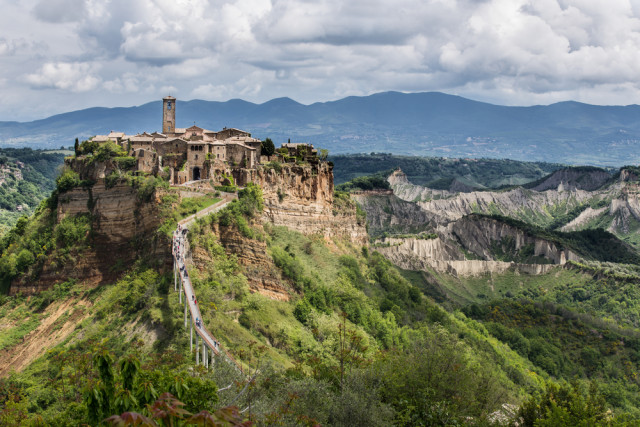
Bagnoregio. Photo: Galindr/Depositphotos
READ ALSO: Ten must-see places within reach of Rome
7. The clifftop artists’ commune of Calcata
If you want to avoid the crowds, head to Calcata, another village balanced on the plateau of a rocky volcanic outcrop. While its approach is not as picturesque as Bagnoregio’s, it is equally as dramatic, with dwellings that seem carved out of the rock face itself perched perilously on its sheer sides. Calcata underwent a revival as a new-age artists’ community in the 1960’s, and while it may no longer be a hippie utopia, you can still find an array of puppet-makers’ dens, artists’ studios, and dressmakers shops scattered throughout the village. The top-floor terrace of Sala da Te, which serves homemade cake along with tens of varieties of tea, offers spectacular views over the valley directly below.
8. The necropolis and waterfalls of Cerveteri
Visitors wax moderately pleased about Cerveteri’s Cerite Museum, a small repository of Etruscan history in the grounds of a former castle, but they thrill at the nearby Banditaccia Necropolis, an Etruscan City of the Dead. This eerie UNESCO world heritage site, whose other-worldly collection of large domed tombs bear a strong resemblance either to the Shire or to Tatooine depending on which universe you prefer to use as your reference point, is an entire city built solely for the purpose of housing corpses. It’s thought that wealthy Etruscans wanted to send their deceased relatives off into afterlife as they had lived in this one, so built them their own town for the purpose.
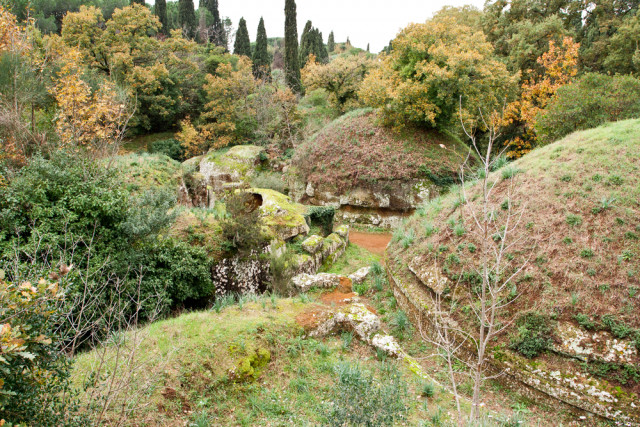
Domed tombs in the Banditaccia necropolis of Cerveteri. Photo: michelealfieri/Depositphotos.
Nature-lovers and adventurers should also seek out Cerveteri’s hidden waterfalls, buried deep in a forest nearby the necropolis. The circular trail, which starts at Cerveteri’s modern cemetery, is poorly marked, so bring plenty of food and water and budget several hours for the round trip.
9. The ghost town of Monterano
Italy is peppered with hundreds of newly-abandoned villages following recent natural disasters, but Antica Monterano has been a ghost town since the 1700s, when it suffered a malaria outbreak and was later sacked by the French army. Its features, which include Etruscan tombs, a Roman aqueduct, a Medieval castle, and a Renaissance cloister, span thousands of years of history and conjure a haunting atmosphere. To find the site you’ll need to drive several miles down a small winding country road and park in a lot a ¼ mile walk away from the ruins themselves.
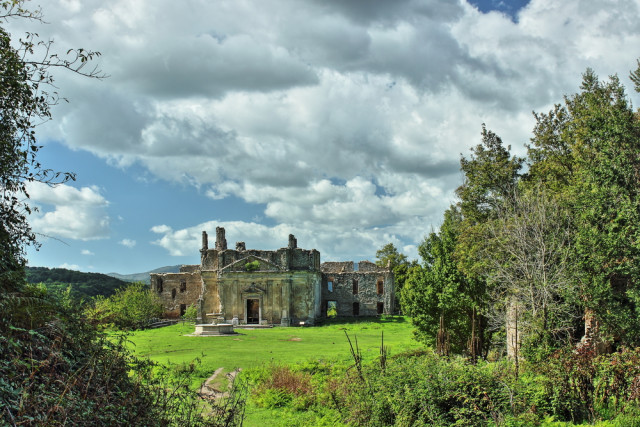
Photo: edimur/Depositphotos
READ ALSO: Where to go in Italy in 2018: Ten travel ideas off the beaten path
10. The monstrous gardens of Bomarzo
The surreal and dream-like garden of Bomarzo, variously nicknamed the Parco dei Mostri (Park of the Monsters) and Il Sacred Bosco (The Sacred Forest), was commissioned in the mid-1500s by the nobleman Pier Francesco Orsini. Thought to be expression of grief following the death of Orsini’s beloved wife, the garden’s erratic layout and monstrous statues with cryptic engravings are an outright rejection of Renaissance landscaping convention. Neglected for several centuries after Orsini’s death, it was restored to its former glory following its rediscovery by Salvador Dali and the Surrealists in the 1940s. The garden, which requires a 10 euro entrance fee, is best experienced on weekdays during term time or in poor weather when visitor numbers are at their lowest.
11. The enchanted forests of Acquapendente
The city and commune of Acquapendente (“Hanging Water”) is located just outside the confines of the Monte Rufeno Nature Reserve, a wildlife sanctuary managed by the city which spans nearly 3000 hectares and nurtures over 1000 plant species. Aquapendente's sites of interest include the village of Torre d’Alfina with its castle that dates back to the early middle ages, but the most compelling reason to pay the area a visit is the Forest of Sasseto, located at the north end of the Monte Rufeno reserve. With its gnarled oaks and chestnuts and green ferns carpeting the forest floor, it's little wonder that the forest is also known as Snow White's Wood and the Forest of the Fairies. Seek out the neo-gothic mausoleum of former Torre d’Alfina Marquis Edoardo Cahen, who owned the forest and restored the castle in the late 19th century.
12. Tuscania, the Pearl of Tuscia
It you want to see Italy through the eyes of the Romantics, few towns can compete with Tuscania, the “Pearl of Tuscia”. Despite being sacked by French forces in 1495 and hit by a major earthquake in 1971, this Etruscan and Medieval town nestled in the Marta River valley has survived intact to form part of a landscape with all the soft-focus dreaminess of a Lorrain painting. Take in the sculpted Etruscan sarcophagi that line the town’s walkways, visit the (free) archaeological museum and the Church of Santa Maria Maggiore, walk up a small slope to the famed San Pietro Church to look back over the town itself, and finally return to eat at one of the trattorias on a piazza with views out over the valley’s gently rolling hills and San Pietro in the middle distance.
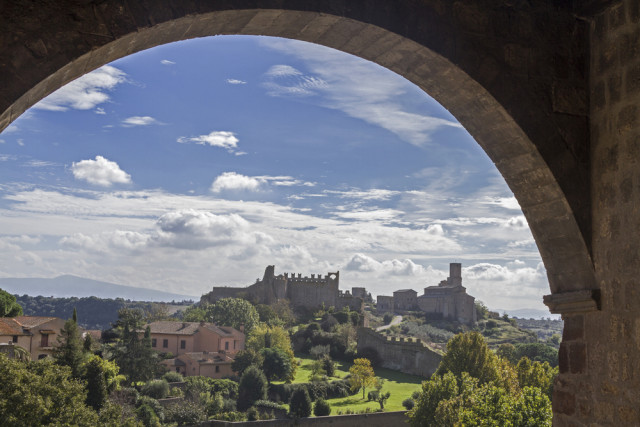
Tuscania. Photo: Tinieder/Depositphotos
13. Tarquinia, kingdom of the Tarquins
Tarquinia was known by the less elegant name of Corneto until 1922, when it rediscovered its Etruscan origins as Tarquinii, home of the Tarquin kings, and had itself re-baptised accordingly. It’s hard to find examples of undamaged Etruscan artwork, but the painted tombs of the Monterozzi Necropolis, (another UNESCO world heritage site), which date back three thousand years, contain an amazingly well-preserved series of frescoes in full colour. The town is also home to a museum with some of the best Etruscan artifacts outside of Rome. Its medieval centre provides a pleasant setting for a stroll, and if you get tired of museums and culture you can head down to the lido a short distance away.
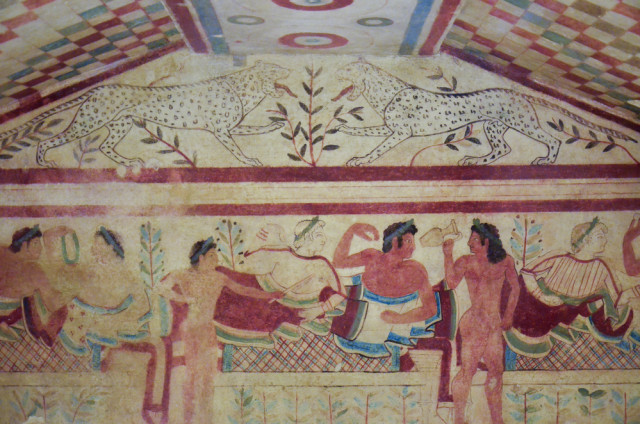
A painted Etruscan tomb in Tarquinia. Picture: wulwais/Depositphotos
14. The mithraeum and amphitheatre of Sutri
The Greeks and the Romans may have popularised the amphitheatre, but they weren’t the only civilisations to make use of it. Aside from being lovely ancient town well worth a visit in its own right, Sutri contains a charmingly crumbling and overgrown Etruscan amphitheatre beside a series of tombs carved into its large volcanic rock. But more unusually than that, its hill also conceals a hidden pagan chapel, a “mithraeum” used as a place of worship by members of the ancient cult of Mithras and later converted into a Christian church. Far from being a simple cave, this chapel burrowed deep into the rock contains elaborate columns and pews, and if you hold up a light up to the walls you can see paintings that date back to the middle ages.
You have to pay to enter the sites, but your ticket comes with an inexpensive guided tour. The ancient structures are all directly on the other side of a main country road across from the town of Sutri and the tombs are visible from the street, so keep an eye out if you’re ever passing though by car.
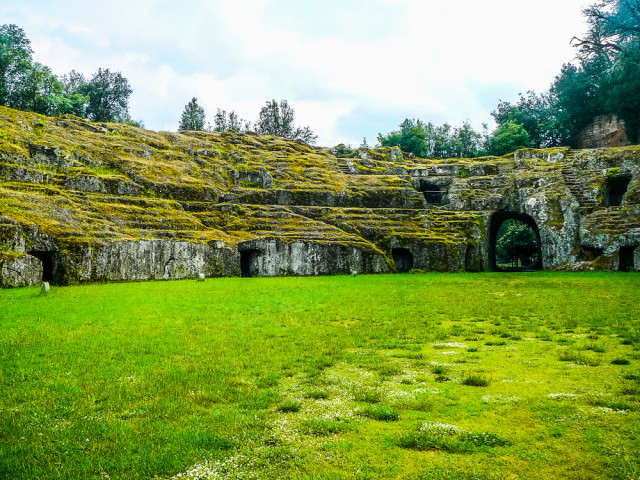
Sutri's Etruscan amphitheatre. Picture: Scrisman/Depositphotos
Did we miss any of your favourite places to visit in northern and western Lazio? Let us know!
Comments (1)
See Also
This large region contains too many places of interest to fit into one article, so we’ve restricted this piece to the provinces of Viterbo and Rome in northern and western Lazio.
Here’s why they should be your next holiday destination.
1. The lakes
The first reason to visit north and west Lazio is really four: the two large lakes of Bracciano and Bolsena, and the two smaller lakes of Martignano and Vico.
Lago di Bracciano is surrounded by the towns of Bracciano, Anguillara Sabazia, and Trevignano Romano, the first two of which can be reached from Rome by train for the price of a couple of cappuccinos. Pay a visit to Odescalchi Castle in Bracciano, walk among the picturesque streets of Anguillara which spill down into the lake, and eat fresh lake fish at one of the many restaurants along the tree-lined waterfront in Trevignano.

Bracciano castle and lake. Photo: Maugli/Depositphotos
If you want to feel truly immersed in nature, make a short trip to the neighbouring Lago di Martignano. You’ll need to drive for several minutes along a bumpy dirt road and park your car a walk away from the lake itself, but you’ll be rewarded with a truly peaceful setting, far from the traffic, amid idyllic grassy banks.

Lago di Martignano. Photo: Elaine Allaby
The more northerly Lago di Bolsena is home to the towns of Bolsena, Marta, and Capodimonte. Relax by the lake in historic Marta and Capodimonte, admire the medieval beauty of the more lively Bolsena, and stop by the town of Montefiascone which offers stunning views over the lake. If you have time, rent a boat or take your own kayak around the islands of Bisentina and Martana. Both islands are privately owned but Bisentina, which houses a Franciscan convent with seven crumbling oratories, recently came into new hands and its current owners are looking at opening it up to tourists.
Roughly midway between Bolsena and Bracciano is the smaller Lago di Vico, which is situated in a nature reserve and is arguably the wildest of the four lakes. Comfort-seekers can rent a sun lounger and dine at one of the bars and restaurants on the south side of the lake, but more adventurous visitors can also explore the unspoilt wildlife around the rest of its perimeter, where hazelnut groves abound and farmers bring herds of pigs and cattle down to the water to drink.
All the lakes are clean enough to swim in and (unlike many of Italy’s beaches) have plenty of undeveloped public shores where you can put down a towel and stay for free.
2. The beaches of Santa Severa and Santa Marinella
If you prefer saltwater to freshwater, head west to the twin beaches of Santa Marinella and Santa Severa, both a short distance from Rome and easily accessible by train. They make up two of the limited number of Italian beaches with free public access, and form part of a golden coastline by the pristine waters of the Tyrrhenian Sea. Santa Severa has a castle on the beach itself which is open to visitors for a small entry fee and is well worth a visit.

Santa Severa's beach and castle. Photo: Maugli/Depositphotos
READ ALSO: 13 places in Italy that look like they belong in a fairy tale
3. The opulent house and gardens of Villa Farnese
Not to be confused with Palazzo Farnese in central Rome where France's embassy to Italy is currently housed, Villa Farnese (confusingly sometimes also called Palazzo Farnese) in Caprarola is a magnificent 16th-century villa with a unique pentagonal shape. Admire the villa’s distinctive spiral staircase, take a walk in its sumptuous rooms decorated in the Mannerist style, which include 500-year-old world atlas frescoes, and stroll among its vast decorative gardens which extend for several acres behind the villa itself.
READ ALSO: Italy's best-kept secrets: Ten must-see places
4. Viterbo, the “City of the Popes”
Being a pope in middle ages, a time when the Catholic Church was beset with conspiracies and intrigue, was a dangerous business. Enter Viterbo, Lazio’s second city after Rome and the refuge of numerous medieval pontiffs. The city traces its origins back to the pre-Roman Etruscan civilisation, but the buildings and streets in its historic centre date back to the 12th and 13th centuries when it rose to prominence as the “City of the Popes” and briefly became the seat of the papacy in 1257. Walk the scenic streets around the papal palace and take a guided underground tour of the Etruscan tunnels which were enlarged and repurposed as secret passageways in medieval times, and later used as air raid shelters during World War II.
5. Natural hot springs
The province of Viterbo in northern Lazio is littered with natural hot springs, and few provide a more relaxing experience than Il Bagnaccio. For an entry fee of 6 euros, you can luxuriate in the warmth of geothermally-heated sulphur water in several rustic pools fashioned out of white clay. Unusually for Italy, Il Bagnaccio is open till late evening almost year-round, including on Christmas and New Year’s Eve. If you’re feeling hungry afterwards, stop by the award-winning Il Babbà pizzeria in the nearby town of Vetralla for some of the best pizza north of Naples.
6. The “dying town” of Bagnoregio
A guide to northern Lazio would be incomplete without mention of Civita di Bagnoregio, a tiny village nestled on top of a volcanic rock that rises abruptly out of the earth like an enchanted kingdom, accessed only by a narrow footbridge. Romantically dubbed “the dying village” as its exposed tuff-rock sides are highly vulnerable to erosion and other natural forces, the village was saved from extinction by outside investment, and is now a major tourist attraction. A small entry fee is required, and be prepared to share your visit with large crowds if you come during high season. If you don’t have time for a leisurely cooked meal, grab a sandwich made with fresh local produce and a scoop of chilled ricotta “ice-cream” with homemade toppings from the Arco del Gusto.

Bagnoregio. Photo: Galindr/Depositphotos
READ ALSO: Ten must-see places within reach of Rome
7. The clifftop artists’ commune of Calcata
If you want to avoid the crowds, head to Calcata, another village balanced on the plateau of a rocky volcanic outcrop. While its approach is not as picturesque as Bagnoregio’s, it is equally as dramatic, with dwellings that seem carved out of the rock face itself perched perilously on its sheer sides. Calcata underwent a revival as a new-age artists’ community in the 1960’s, and while it may no longer be a hippie utopia, you can still find an array of puppet-makers’ dens, artists’ studios, and dressmakers shops scattered throughout the village. The top-floor terrace of Sala da Te, which serves homemade cake along with tens of varieties of tea, offers spectacular views over the valley directly below.
8. The necropolis and waterfalls of Cerveteri
Visitors wax moderately pleased about Cerveteri’s Cerite Museum, a small repository of Etruscan history in the grounds of a former castle, but they thrill at the nearby Banditaccia Necropolis, an Etruscan City of the Dead. This eerie UNESCO world heritage site, whose other-worldly collection of large domed tombs bear a strong resemblance either to the Shire or to Tatooine depending on which universe you prefer to use as your reference point, is an entire city built solely for the purpose of housing corpses. It’s thought that wealthy Etruscans wanted to send their deceased relatives off into afterlife as they had lived in this one, so built them their own town for the purpose.

Domed tombs in the Banditaccia necropolis of Cerveteri. Photo: michelealfieri/Depositphotos.
Nature-lovers and adventurers should also seek out Cerveteri’s hidden waterfalls, buried deep in a forest nearby the necropolis. The circular trail, which starts at Cerveteri’s modern cemetery, is poorly marked, so bring plenty of food and water and budget several hours for the round trip.
9. The ghost town of Monterano
Italy is peppered with hundreds of newly-abandoned villages following recent natural disasters, but Antica Monterano has been a ghost town since the 1700s, when it suffered a malaria outbreak and was later sacked by the French army. Its features, which include Etruscan tombs, a Roman aqueduct, a Medieval castle, and a Renaissance cloister, span thousands of years of history and conjure a haunting atmosphere. To find the site you’ll need to drive several miles down a small winding country road and park in a lot a ¼ mile walk away from the ruins themselves.

Photo: edimur/Depositphotos
READ ALSO: Where to go in Italy in 2018: Ten travel ideas off the beaten path
10. The monstrous gardens of Bomarzo
The surreal and dream-like garden of Bomarzo, variously nicknamed the Parco dei Mostri (Park of the Monsters) and Il Sacred Bosco (The Sacred Forest), was commissioned in the mid-1500s by the nobleman Pier Francesco Orsini. Thought to be expression of grief following the death of Orsini’s beloved wife, the garden’s erratic layout and monstrous statues with cryptic engravings are an outright rejection of Renaissance landscaping convention. Neglected for several centuries after Orsini’s death, it was restored to its former glory following its rediscovery by Salvador Dali and the Surrealists in the 1940s. The garden, which requires a 10 euro entrance fee, is best experienced on weekdays during term time or in poor weather when visitor numbers are at their lowest.
11. The enchanted forests of Acquapendente
The city and commune of Acquapendente (“Hanging Water”) is located just outside the confines of the Monte Rufeno Nature Reserve, a wildlife sanctuary managed by the city which spans nearly 3000 hectares and nurtures over 1000 plant species. Aquapendente's sites of interest include the village of Torre d’Alfina with its castle that dates back to the early middle ages, but the most compelling reason to pay the area a visit is the Forest of Sasseto, located at the north end of the Monte Rufeno reserve. With its gnarled oaks and chestnuts and green ferns carpeting the forest floor, it's little wonder that the forest is also known as Snow White's Wood and the Forest of the Fairies. Seek out the neo-gothic mausoleum of former Torre d’Alfina Marquis Edoardo Cahen, who owned the forest and restored the castle in the late 19th century.
12. Tuscania, the Pearl of Tuscia
It you want to see Italy through the eyes of the Romantics, few towns can compete with Tuscania, the “Pearl of Tuscia”. Despite being sacked by French forces in 1495 and hit by a major earthquake in 1971, this Etruscan and Medieval town nestled in the Marta River valley has survived intact to form part of a landscape with all the soft-focus dreaminess of a Lorrain painting. Take in the sculpted Etruscan sarcophagi that line the town’s walkways, visit the (free) archaeological museum and the Church of Santa Maria Maggiore, walk up a small slope to the famed San Pietro Church to look back over the town itself, and finally return to eat at one of the trattorias on a piazza with views out over the valley’s gently rolling hills and San Pietro in the middle distance.

Tuscania. Photo: Tinieder/Depositphotos
13. Tarquinia, kingdom of the Tarquins
Tarquinia was known by the less elegant name of Corneto until 1922, when it rediscovered its Etruscan origins as Tarquinii, home of the Tarquin kings, and had itself re-baptised accordingly. It’s hard to find examples of undamaged Etruscan artwork, but the painted tombs of the Monterozzi Necropolis, (another UNESCO world heritage site), which date back three thousand years, contain an amazingly well-preserved series of frescoes in full colour. The town is also home to a museum with some of the best Etruscan artifacts outside of Rome. Its medieval centre provides a pleasant setting for a stroll, and if you get tired of museums and culture you can head down to the lido a short distance away.

A painted Etruscan tomb in Tarquinia. Picture: wulwais/Depositphotos
14. The mithraeum and amphitheatre of Sutri
The Greeks and the Romans may have popularised the amphitheatre, but they weren’t the only civilisations to make use of it. Aside from being lovely ancient town well worth a visit in its own right, Sutri contains a charmingly crumbling and overgrown Etruscan amphitheatre beside a series of tombs carved into its large volcanic rock. But more unusually than that, its hill also conceals a hidden pagan chapel, a “mithraeum” used as a place of worship by members of the ancient cult of Mithras and later converted into a Christian church. Far from being a simple cave, this chapel burrowed deep into the rock contains elaborate columns and pews, and if you hold up a light up to the walls you can see paintings that date back to the middle ages.
You have to pay to enter the sites, but your ticket comes with an inexpensive guided tour. The ancient structures are all directly on the other side of a main country road across from the town of Sutri and the tombs are visible from the street, so keep an eye out if you’re ever passing though by car.

Sutri's Etruscan amphitheatre. Picture: Scrisman/Depositphotos
Did we miss any of your favourite places to visit in northern and western Lazio? Let us know!
Join the conversation in our comments section below. Share your own views and experience and if you have a question or suggestion for our journalists then email us at [email protected].
Please keep comments civil, constructive and on topic – and make sure to read our terms of use before getting involved.
Please log in here to leave a comment.